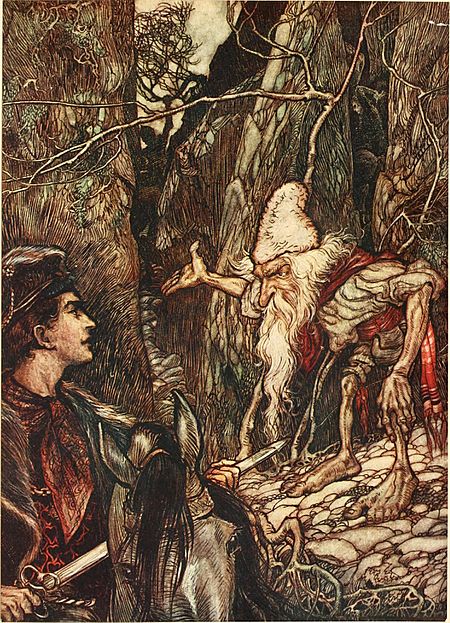The Water of Life (German fairy tale) facts for kids
"The Water of Life" (German: Das Wasser des Lebens) is a German fairy tale collected by the Brothers Grimm, tale number 97.
It is Aarne-Thompson type 551.
John Francis Campbell noted it as a parallel of the Scottish fairy tale, The Brown Bear of the Green Glen.
Synopsis

A king was dying. An old man told his sons that the water of life would save him. Each one set out in turn. The two older ones, setting out in hopes of being the heir, were rude to a dwarf on the way and became trapped in ravines. When the youngest son went the dwarf asked where he was going, and he told him. The dwarf told him it was in a castle, and gave him an iron wand to open the gates and two loaves to feed to the lions inside. Then he had to get the water before the clock struck 12 when the gates would shut again.
He opened the gate with the wand and fed the lions the bread. Then he came to a hall where there were sleeping princes, and he took rings from their fingers and some bread and a sword from the table. He went on and found a beautiful princess, who kissed him, told him he had freed her, and promised to marry him if he returned within a year. Then she told him where the spring was. He went on, but saw a bed and lay down to sleep. When he woke, it was a quarter to twelve. He sprang up, got the water, and escaped, with the closing gate taking off the heel of his boot.
He met the dwarf who told him what happened to his brothers and at his imploring freed them, warning that they had evil hearts. They came to a kingdom plagued by war and famine, the prince killed their foes with the sword and fed them with the loaf. Then they came to two more kingdoms in the same situation, and they did the same. Then they got on a ship to cross the sea and come home. The older brothers stole the water of life and filled his bottle with sea water.
The king was sickened by the sea water. The older brothers accused the youngest of trying to poison him and gave him the water of life. The king decided to have his youngest son secretly killed (as punishment). He sent a huntsman with him into the woods, but the huntsman was unable to bring himself to kill him and confessed the deed to the prince. The prince and the huntsman swapped clothes and the prince fled.
Treasure arrived, from the three kingdoms the youngest prince had saved, and the king wondered about his guilt and regretted having his son killed. The huntsman confessed that he had not killed him, and so the king issued a proclamation that he could freely return.
The princess in the castle had made a golden road to it and told her people that it would bring her true groom to her and to admit no one who did not ride straight up it. The two older princes (who were pretending to be the ones who freed her) saw it and thought it would be a shame to get it dirty, so they rode alongside, and the servants did not admit them. The youngest thought so constantly of the princess that he did not notice it, so he rode up it, was admitted, and they married. The prince went back to his father and told the true story. The king wished to punish the older brothers, but they had already boarded a ship and were never seen again.
Variants
Swedish folktale collectors George Stephens and Gunnar Olof Hyltén-Cavallius listed "The Water of Life" as a German variant close to the Swedish version they collected (Ungdoms-Landet; English: "The Land of Youth"). They also metioned a Russian variant titled Das Märchen von Ljubin Czarewitsch, der schönen Czarewna, seiner Gemahlinn, und dem beflügelten Wolf, which was translated years later as Story of Lyubim Tsarevich and the Winged Wolf and Prince Lubim and the Winged Wolf.
In an Indian variant, The Rose of Bakawali (Gul-e-Bakawali), the king becomes blind and, on his doctors's orders, sends his five sons for the only possible cure: the magical rose of the fairy princess Bakawali. W. A. Clouston saw the quest for the magical flower as a parallel to the German fairy tale "The Water of Life".
In several variants, the object that can cure the king is either the water of youth (or of life and death) or a magical bird, sometimes both, such as in Hungarian variant Der Fink mit der goldenen Stimme ("The finch with the golden voice"). At the end of the tale, the fairy maiden or foreign princess travels with her army or navy to the prince's kingdom in order to find the man who stole her wonderful bird or magical water.
In Estonian sources, the tale type is known as Imelik peegel ("The Wonderful Mirror"), after a homonymous story by author Juhan Kunder.

